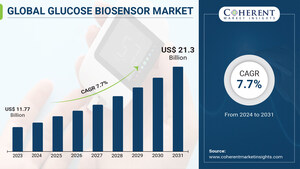BURLINGAME, Calif., Jan. 25, 2024 /PRNewswire/ -- CoherentMI published a report, titled, Japan Rail Freight Transport Market was valued at US$ 7.8 Billion in the year 2023, and is anticipated to reach a US$ 10.6 Billion by 2030, with growing at a CAGR of 4.1% during forecast period 2023-2030.
Japan Rail Freight Transport Market is driven by several factors that are contributing to its growth. Firstly, the increasing demand for efficient and sustainable logistics solutions is propelling the market. Rail freight transport is considered to be an environmentally-friendly mode of transportation as it produces lower carbon emissions compared to other modes such as road or air transport. Moreover, rail freight is known for its capacity to transport large quantities of goods over long distances, making it a preferred choice for industries that require bulk transportation. Additionally, the government initiatives to promote rail freight transport and improve the infrastructure further contribute to the market growth. These initiatives include the expansion of rail networks, development of dedicated freight corridors, and implementation of advanced technologies to enhance operational efficiency.
Market Snapshot:
Report Coverage |
Details |
Study Period |
2023 - 2030 |
Base Year of Estimation |
2022 |
CAGR |
4.1 % |
Largest Market |
Japan |
Market Concentration |
High |
Major Players |
Meitetsu Transportation, Kintetsu Railway, Freight Transport |
Segments Covered |
By Service Type, By End-User Industry, By Distance, By Rail |
Report Coverage |
Revenue Forecast, Competitive Landscape, Growth Factors, |
Trends |
• Focus on Cold Chain and Temperature-Controlled Logistics |
Key Market Takeaways:
- Japan Rail Freight Transport Market Size is anticipated to witness a CAGR of 4.1% during the forecast period 2023-2030, owing to the growing demand for efficient and reliable transportation of goods in the country.
- On the basis of service type, the intermodal segment is expected to hold a dominant position, due to its ability to seamlessly transfer cargo between different modes of transport such as rail, road, and sea. This segment is projected to grow significantly, driven by its cost-effectiveness and reduced carbon emissions compared to other modes of transportation.
- In terms of end-user industry, the chemical industry is dominating the market. The demand for rail freight transport in the chemical industry is driven by the need to transport hazardous and sensitive materials safely and securely. The automotive, energy, construction, and food & beverages industries also contribute to the market growth.
- Based on distance, the 500-1000 km segment is expected to dominate the market. This is attributed to the fact that this distance range covers major industrial hubs and ports in Japan, making it ideal for transporting goods efficiently. However, the demand for rail freight transport is expected to increase in longer distance segments as industries expand their operations.
- When it comes to the rail network, the Shinkansen lines are dominating the market. The Shinkansen, also known as the bullet train, is known for its high speed and reliability. It is the preferred choice for transporting freight, especially perishable goods, due to its quick delivery and efficient handling.
- In terms of region, North America is expected to hold a dominant position in the Japan Rail Freight Transport Market. This is due to the strong trade relations between Japan and North American countries, resulting in a significant volume of goods being transported between the two regions.
- Key players operating in the Japan Rail Freight Transport Market include Meitetsu Transportation, Kintetsu Railway, Freight Transport of JR Hokkaido, Freight Transport of JR Shikoku, Freight Transport of JR Central, Japan Freight Railway Company, West Japan Railway Company, Freight Transport of JR East, Freight Transport of JR West, Freight Transport of JR Kyushu, Japan Freight Railway Company, Nagoya Railroad, Seino Transportation, Keihan Electric Railway, Keisei Electric Railway, Odakyu Electric Railway, Tobu Railway, Seibu Railway, East Japan Railway Company, and Kyushu Railway Company. These key players contribute to the competitive landscape of the market and are constantly striving to enhance their services to meet the growing demand for rail freight transport.
Market Trends:
Japan rail freight transport market is witnessing two key trends that are shaping its future growth. Firstly, the adoption of technology and automation in rail freight operations is gaining traction. The use of technologies such as Internet of Things (IoT), artificial intelligence (AI), and advanced analytics enables real-time monitoring, predictive maintenance, and optimization of freight operations. These technologies enhance the efficiency, reliability, and safety of rail freight transport, thereby attracting more customers and driving market growth. Secondly, the market is experiencing a shift towards intermodal transportation. Intermodal transportation involves the use of multiple modes of transportation, such as rail, road, and sea, to transport goods from the point of origin to the destination. It offers flexibility, cost-efficiency, and reduced transit times, making it a preferred choice for industries with complex and diverse transportation requirements. The growing adoption of intermodal transportation is expected to drive the growth of the japan rail freight transport market in the coming years.
Recent development:
- In January 2022, to meet energy efficiency requirements, knorr-bremse presented its new generation compressor and dryers for rail freight application.
- In March 2021, Hitachi Rail introduced cargo suspension technology optimised for rail freight transportation to improve comfort and dependability.
Read complete market research report, "Japan Rail Freight Transport Market Size And Share Analysis - Growth Trends And Forecasts (2023 - 2030)", Published by CoherentMI.
In conclusion, the Japan Rail Freight Transport Market is expected to grow at a steady pace during the forecast period. The dominance of the intermodal service type, chemical industry, 500-1000 km distance segment, Shinkansen lines, and North America region highlight the key opportunities in the market. Key players in the market play a crucial role in meeting the growing demand and improving the efficiency of rail freight transport in Japan.
Japan Rail Freight Transport Market Segmentation:
- By Service Type
- Intermodal
- Tank wagons
- Freight cars
- Refrigerated cars
- Logistics
- Others
- By End-User Industry
- Chemical, Automotive
- Energy
- Construction
- Food & Beverages,
- Others
- By Distance
- 500-1000 km
- 1000-1500 km
- 1500-2000 km
- 2000-2500 km
- 2500-3000 km
- Above 3000 km
- By Rail Network
- Shinkansen
- Conventional Lines
- Regional Lines
- Freight Lines
- Private Lines
- Others
Buy this premium report now @ https://www.coherentmi.com/industry-reports/japan-rail-freight-transport-market/buyNow
Top Questions Answered in this Report:
- What factors are impeding the growth of the market for Japan Rail Freight Transport?
- What are the primary drivers fostering growth in the market for Japan Rail Freight Transport?
- Which segment stands out as the leading component in the Japan Rail Freight Transport Market?
- Who are the key players actively involved in the Japan Rail Freight Transport Market?
- Which region is poised to take the lead in the Japan Rail Freight Transport Market?
- What is the projected CAGR for the Japan Rail Freight Transport Market?
Find More Trending Reports Below:
Global Space Economy Market is Segmented By Type (Satellite Manufacturing & Launching, Ground Stations & Equipment, Space Launch Services, Satellite Services, Space Insurance, Others), By Orbit (LEO, MEO, GEO, Beyond GEO), By End User (Commercial, Government & Military, Consumer, Others), By Application (Communications, Earth Observation & Remote Sensing, Technology Development, Navigation & Space Science, Others), By Payload (Communication, Imaging, Navigation, Others), By Geography (North America, Latin America, Europe, Asia Pacific, Middle East & Africa). The report offers the value (in USD Billion) for the above-mentioned segments.
Pag Base Stock Market is Segmented By Base Oil Type (Group I, Group II, Group III, Group IV, Group V), By Application (Automotive Oil, Industrial Oil, Hydraulic Oil, Grease, Metalworking Fluid, Others), By End Use Industry (Automotive, Industrial, Construction, Marine, Others). The report offers the value (in USD billion) for the above-mentioned segments.
Global Oil Free Air Compressor Market is Segmented By Type (Oil-free Rotary Screw Compressors, Oil-free Reciprocating Compressors, Oil-free Centrifugal Compressors, Others), By End-use Industry (Power Generation, Food & Beverage, Pharmaceuticals, Home Appliances, Textile, Oil & Gas, Others, By Power Rating (0-50 HP, 51-250 HP, 251-500 HP, Above 500 HP), By Pressure (0-20 Bar, 21-100 Bar, 101-350 Bar, Above 350 Bar), By Geography (North America, Latin America, Europe, Asia Pacific, Middle East & Africa). The report offers the value (in USD Billion) for the above-mentioned segments.
About Us:
At CoherentMI, we are a leading global market intelligence company dedicated to providing comprehensive insights, analysis, and strategic solutions to empower businesses and organizations worldwide. Moreover, CoherentMI is a subsidiary of Coherent Market Insights Pvt Ltd., which is a market intelligence and consulting organization that helps businesses in critical business decisions. With our cutting-edge technology and experienced team of industry experts, we deliver actionable intelligence that helps our clients make informed decisions and stay ahead in today's rapidly changing business landscape.
Contact Us:
Mr. Shah
Senior Client Partner – Business Development
CoherentMI
Phone:
U.S.: +1-206-701-6702
U.K: +44-020-8133-4027
JAPAN: +81-50-5539-1737
INDIA: +91-848-285-0837
Email: sales@coherentmi.com
Website: https://www.coherentmi.com
Logo - https://mma.prnewswire.com/media/902389/Coherent_Market_Insights_Logo.jpg




Share this article